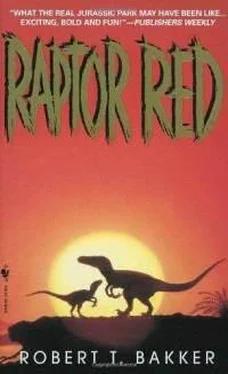The dactyl examines the raptors carefully. He recognizes three of the four adults, but the chicks are mostly new to him. The way the chicks play with the adults shows that there are two raptor packs mixed together. One is led by Raptor Red’s niece and her consort, a short but powerfully built male. The other pack belongs to Raptor Red and her mate.
The white dactyl’s shadow passes over the packs. Five tiny, timid Utahraptor faces look up at him. Two tiny chicks lie down next to Raptor Red’s niece. Three snuggle between Raptor Red and her mate.
Both families retire later to their nests in the cave. The dactyl notes with satisfaction that the combined dung-scent posts of the two Utahraptor packs are respected by all other predators. The deinonych packs in particular shudder with apprehension when they sniff the air at the base of the hill, and they never dare to come closer than a mile.
Raptor Red watches the old dactyl make his familiar spirals over her head. Another gigantic set of white wings joins him, and the two pterodactyls engage in spectacular dives and zoom-climbs, gurgling greetings to each other and making elaborate neck movements.
The old white dactyl has taken a new mate. Late in the summer, three young dactyls join the two adults.
Ten years later the plague of acrocanthosaurs recedes when the big predators themselves are hit hard by multiple epidemics that rage through their dense populations. Some acros survive, but they will never build their numbers back up to extreme levels. Utahraptors - children and grandchildren and great-grandchildren of Raptor Red and her sister - will descend from their montane stronghold and colonize the low-lying floodplains and river-edge forest.
The sixth generation will invade Siberia, crossing the North Pacific land bridge that their ancestors used when they entered North America going the other direction. For two million years, Utahraptor will reign as top predator.
The family of Raptor Red will leave a legacy for the modern world. Where her first mate died, at the scene of the Astrodon fight, geological processes will seal the record. During the winter rains, a flash flood will cut a swath through the dried lake mud, ripping up gobs of sediment, carrying mud and bones a half-mile away to a shallow depression in the floodplain. Other dried-up dinosaur carcasses will come to rest here too - the armor-plated hide of a nodosaur lies jumbled against the astro and raptor bones.
A hundred million years of geologic time will do its work over the scene. First, layer after layer of mud and sand are heaped over the bones - every major flood brings in two or three feet more. During the successive epochs, a mile of sediment accumulates - some of it brought in by rivers, some by the shallow oceans that cover this part of Utah in the second half of the Cretaceous Period.
At last the oceans drain away, and the landscape rises. Hundreds of miles to the west, volcanic islands collide with the Pacific coast of North America. Then a microcontinent crushes into the coast. Repeated geological collisions release heat and compressive forces throughout Utah and Colorado, and mountains rise. The even layers of sediment, now hardened to rock, are fractured, twisted, and bent.
This parcel of real estate becomes a jagged landscape of young mountains, high plateaus, and interior desert basins. Ice ages come and go and come again, sending heavy spring and winter rains to engorge the mountain rivers that cut deep arroyos through the many-layered sediment pile. In Africa a smart species of ape is evolving into a higher primate with the ability to chip stone tools and tame fire. This primate will spread to every continent, and learn to write down its experiences, and wonder how mountains formed and what fossils mean.
By the late summer of 1991, erosion has eaten into the tomb of the raptor and the astro. Their bones are rock-hard, permeated with mineral-rich water that fills every pore with brittle calcite mineral. As the floodplain rock crumbles away under the influence of rain and frost and summer heat, broken bits of fossil bone tumble down the slopes of the gullies. Telltale bone fragments lie everywhere, signals to alert humans that a dinosaurian bonanza awaits excavation by skilled hands.
In 1994 scientists will announce the discovery of more giant raptors in the sediments of Asia. Kids who love dinosaurs, and adults too, will name giant raptors as their second favorite dinosaur, after Tymnnosaurus rex. A significant minority - twenty percent or so - will say they like Utahraptor best.
I think a lot about Raptor Red and the other raptor species, where they fit into the history of life, and how we’ve pieced together their lifestyle from the bits and pieces of evidence gleaned from the rocks. The entire history of the Dinosauria is 165 million years long, and Utahraptor flourished for just a thin slice of that history, a million years or so. To understand the great raptors, we must probe their ancestry and the ways of life of their descendants.
As I write this epilogue, the field season has begun in Wyoming, and I drive my beat-up 1980 Datsun pickup from the lodge to the dinosaur beds every morning. If I take the long way to our quarries, I can travel through a hundred million years of Mesozoic history, laid out in the successive strata. It was during this time interval that the forces of evolution created the raptor family from very primitive dinosaurian ancestors.
Each rock layer is a punctuation mark in Raptor Red’s heritage.
The truck bumps over the dirt road, deeply rutted by last winter’s rains, and my progress is marked by a crimson dust cloud as the tires churn up the red sediment of the Chugwater Formation. The Chug is from the Triassic age, 220 million years ago - the Dawn of the Age of Dinosaurs. Fossil footprints in the red and maroon siltstones record a momentous event, the evolutionary debut of the first predatory dinosaurs, flesh-eaters ranging from fox to wolf-size, the beginning of the family tree that would ultimately produce Raptor Red and her clan.
The fundamentals of Utahraptor’s adaptive personality were being established in Chugwater times. The fast-acting legs, hearts, and lungs were there, and so were the social bonds. Raptor Red’s Triassic ancestors already had a fast-stepping style of movement that left birdlike tracks in the lake-shore sediments. Each footprint has three toes pointing forward and one pointing back - the avian pattern - and the dinosaurs always walked on their toes, keeping their ankles off the ground.
I’ve tramped over the Triassic redbeds in many places - Massachusetts, Colorado, Wyoming, South Africa. Everywhere the impression you get is the same - these early dinosaurs were moving at hot-blooded speeds. There’s a simple equation that lets you calculate how fast a dinosaur was moving from the stride length of the fossil tracks plus the length of the leg. When you plug the Chugwater trackway data into the formula, the results are astounding. On average, the dinosaurs were cruising around at four or five miles per hour, as fast as a pack of coyotes do today. Top speeds were probably forty miles per hour or more. No cold-blooded creature walks and runs that fast.
And these earliest dinos were social predators. Many redbed trackway sites show a dozen predators - all of the same size and the same species -moving together.
Fossil skeletons of Chugwater age add more evidence that the ur-dinosaurs were operating at a high metabolic level. Neck bones and torsos have deep cavities that in life must have been filled with air chambers arranged just like those of birds. This pneumatic system gives birds the highest lung efficiency possible in any living species, far better than that of lizards or crocs or even us humans. When Chugwater dinosaurs breathed, the air passed through a high-tech ductwork system, built to an avian blueprint, that supplied oxygen to all the body tissues at a tremendous rate.
Читать дальше












